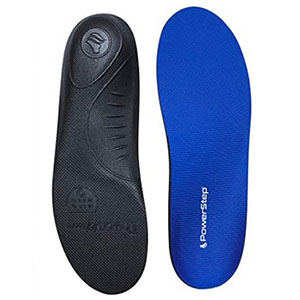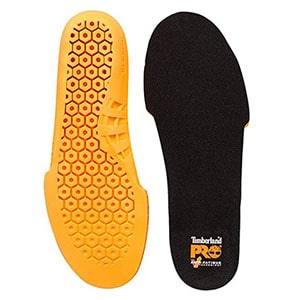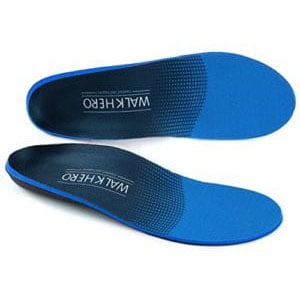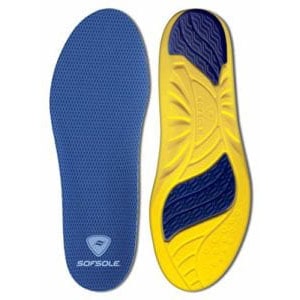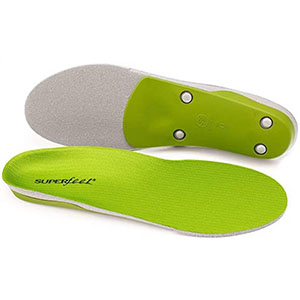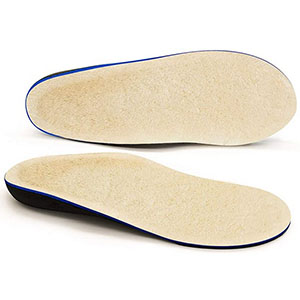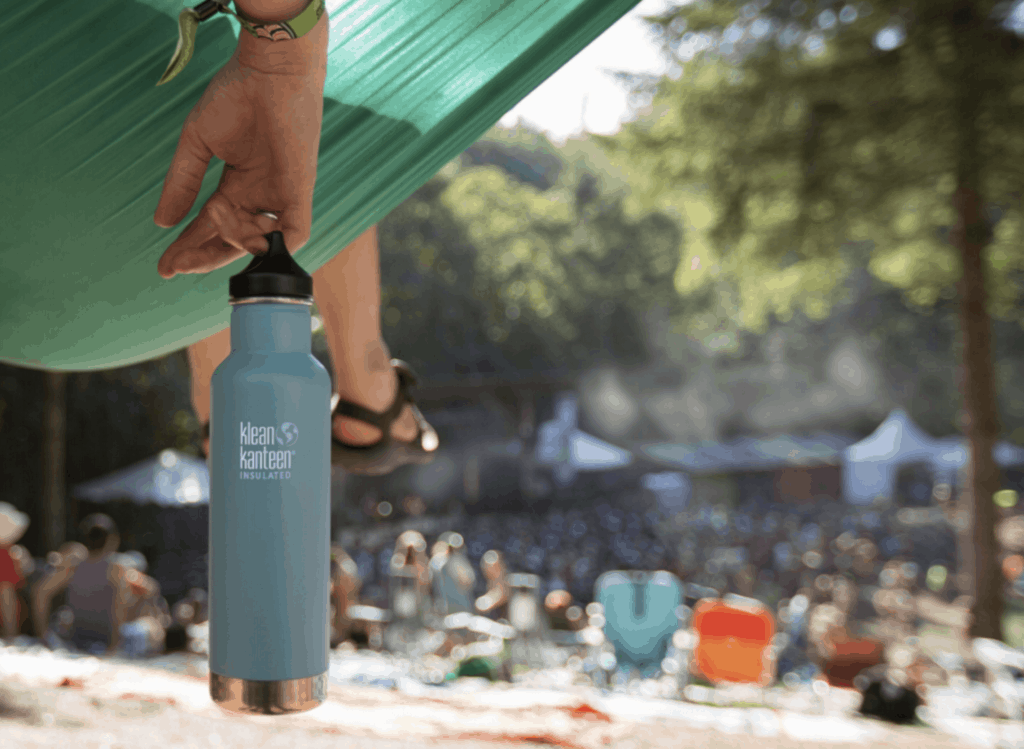Insoles are simple devices inserted into your shoes that absorb shocks, provide arch support and help ensure proper foot alignment when walking, running or exercising.
Insoles can be used to prevent common foot problems or to alleviate pain and discomfort from plantar fasciitis, Achilles tendonitis and other conditions.
Whether you work on your feet, are athletically inclined, or are suffering from one of the aforementioned conditions there is an insole that can help. Our testers put dozens of today’s most brands to the test to compile the following list of the best insoles of 2021.
1. Powerstep Full Length Orthotic Insoles
Powerstep Full Length Orthotic Insoles are designed for both men and women. They provide outstanding support from arch to heel, absorb shocks like a sponge and stay put inside your shoe all day long. Although they are double-cushioned they are still thin and discreet and won’t crowd you out of your shoes.
Powerstep Insoles have an antimicrobial polyester lining that prevents bacterial buildup and a neutral, unisex design that will accommodate any type of foot. If you suffer from heel pain, plantar fasciitis, neuroma or fallen arches Powerstep Orthotic insoles are a smart choice. As a bit of icing on the cake these comfortable, durable insoles are reasonably priced and easy to clean.
2. Timberland Pro Anti-Fatigue Insole
Timberland Pro Anti-Fatigue Insoles are as close as you’ll come to a one-size-fits all custom-style orthotic insole. They’re fashioned from lightweight inverted-cone foam that absorbs shocks while providing an assistive spring that aids in effortless movement. Arch support is outstanding and will enable people with fallen (or falling) arches to resume a normal gait, free of discomfort.
Timberland Pro Anti-Fatigue Insoles will slip easily into work boots, climbing boots, running shoes, wingtips and just about every other type of footwear. Timberland customer service is also a cut above what you’ll find with most other manufacturers. Those dealing with heel pain, neuroma, ankle tendonitis, or flat feet, or who want to avoid developing foot problems down the line, are going to find these comfortable, durable insoles to be just what the doctor ordered.
3. Walk Hero Support Insoles
There’s a lot to like when it comes to Walk Hero Support Insoles, starting with how effectively they mitigate pain and stiffness of plantar fasciitis. These are multilayered insoles that absorb shocks all day long, promote a smooth, natural stride and relieve pressure on your heel and ankles that is a common side effect of plantar fasciitis.
Another thing we like about these insoles is that they’re designed to accommodate both men and women’s feet. And they’re sheathed in an antimicrobial fabric that keeps odors at bay no matter how hard you work. Walk Hero Support Insoles slip easily into most shoes and stay put until the day is done. They also happen to be one of the most affordable entries on our list, which means they’re an outstanding value as well.
4. Easyfeet Arch Support Insoles for Men and Women
Speaking of outstanding values, the Easyfeet Arch Support Insoles for Men and Women are all of that and more. These handsome, comfortable, durable insoles feature a memory foam base and a firm but forgiving TPU arch that effectively counteracts fallen arches and promotes proper heel to toe motion as you walk or run. Those with plantar fasciitis will appreciate that firm arch support. As will anyone who spends large portions of the day on their feet.
Considering the price, the level of support and shock absorption these insoles provide is pretty extraordinary. It’s a level of overall comfort we’d expect in insoles costing two or three times as much. We found that they did move around a bit inside work boots. But with just about every other style of shoe they were rock solid.
5. Redi-Thotics Flex Orthotic Insoles
Redi-Thotics Flex Orthotic Insoles have a deceptively simple look about them. But don’t let that fool you. These are first-rate insoles that provide a range of benefits and are built to last. Arch support is excellent and unwavering, no matter how long you spend on your feet. Although the heel padding is not exactly robust, it is nonetheless surprisingly effective. And the design of the heel cup is such that your feet never wander inside your shoes.
Red-Thotics Insoles are marketed as being compatible with all types of shoes. We found them to be an excellent match with running shoes, loafers, flats and work boots. The textured surface also helps them stay put once placed inside the shoe.
6. Dr. Scholl’s Running Insoles
When it comes to things like insoles Dr. Scholl’s has the kind of brand recognition others can only dream of. (Which is why American investment firm Yellow Wood was willing to pay more than half a billion dollars for the brand last year.) Part of that is because they’ve been around for decades. But another reason is that they produce insoles and shoe inserts of reliably high quality year after year.
Dr. Scholl’s Running Insoles are yet another example of the many things the company does right. These insoles eat shocks for breakfast, lunch and dinner, provide relief from plantar fasciitis, shin splints and heel pain and are treated to prevent bacterial buildup and the resulting odors. They’re extremely comfortable, reasonably priced and slip into just about any type of shoe.
7. Sof Sole Performance Insoles
Sof Sole Performance Insoles are designed with active guys in mind. They provide copious padding in the heel and firm, unyielding support through the arch. Unlike a lot of OTC insoles they also provide gel cushioning in the ball of the foot. This makes them particularly appropriate for those engaged in sports like football and basketball.
Sof Sole Insoles also offer something the company calls ‘hydrologix moisture management’, which is designed to wick away moisture so your feet can remain dry and comfortable inside your shoes while you’re jockeying for position under the boards. But don’t think these are just for athletes. Anyone who spends long hours on their feet is going to love these affordable, comfortable, durable insoles.
8. Superfeet Green Insoles
Superfeet makes a lot of high-quality insoles, none better than their Green Insoles. Green Insoles sport a unique stabilizer cap in the heel that works in concert with the deep heel cup to help prevent your foot from tilting left or right when under pressure. Superfeet Green Insoles also prevent bacteria from gaining a foothold and causing odors. And they can be easily trimmed to fit any style shoe.
Arch support in the Green Insole is dependable, if not spectacular. But build quality, durability and comfort are right up there with the best. Superfeet Green Insoles are guaranteed to hold their shape for 12 months or 500 miles, whichever comes first. And considering the price, that kind of guarantee is important.
9. Walk Hero Sheepskin Arch Support Orthotic Insoles
Winter can be hard on your feet and most insoles don’t do a lot to address that. Hunters, ice climbers, trekkers, beat cops and construction workers all know what it feels like when their feet turn to ice blocks on cold winter days. Walk Hero Sheepskin Arch Support Orthotic Insoles let you tackle two problems simultaneously.
You get the firm arch support and outstanding shock absorption you need to fend off foot problems. At the same time, the sheepskin footbed helps prevent the cold, cold earth from pulling heat out of the soles of your feet. It’s the kind of double-barreled benefit we like to see. And they won’t cost you an arm and a leg either.
10. Superfeet High Arch Support Insoles
For the last of our best insoles we dig into the Superfeet well one more time. Their High Arch Support Insoles are great for those with fallen arches or folks suffering from plantar fasciitis. As is the case with their ‘Green Insoles’ (see above), these have a hard heel cap that envelops the back end of the sole and prevents your feet from sagging left or right when you change directions.
Shock absorption up front is outstanding thanks to the high impact foam that underpins the ball of the foot and the toes. If there is a downside it’s that you can forget about trimming them to fit into your shoes better. It can be done, but you’ll mangle them in the process. So make sure you buy the right size.
FAQs
What are the Benefits of Wearing Insoles?
Insoles provide arch support. Your arches have a tough job. They’re tasked with absorbing tons of downward pressure every single day. Over time all the stress and strain can become too much and the posterior tibial tendon gives way (1). The result: fallen arches. But it doesn’t have to be. A good pair of insoles with robust arch support can prevent your arches from collapsing over time and ensure your feet can continue to function the way evolution intended.
Insoles prevent foot problems. Most people take their feet for granted until there’s a problem. Then it’s often too late to reverse the damage and they need to figure out a way to live with the new, compromised reality. But why wait until chronic foot problems rear their ugly head to do something? Using insoles now, when your feet are still healthy, will go a long way toward ensuring they stay that way.
Insoles may prevent shin splints. Often times when people decide to turn over a new leaf and begin exercising they overdo it. Shin splints (2) are a common result of this type of over-enthusiasm. Shin splints are tiny tears that develop in the bone and muscle tissue of the lower leg. They typically befall older folks and they can be very painful. Wearing insoles can help prevent shin splints. Or, if you already suffer from them, insoles can alleviate much of the pain and discomfort.
Insoles provide cascading benefits. In the words of the old spiritual song “the toe bone’s connected to the foot bone, the foot bone’s connected to the heel bone, the heel bone’s connected to the ankle bone etc.” Why are we bringing this up? Because it points to the fact that the bones of the foot, leg and back are connected. As such, what’s good for your feet (insoles) will also be good for you legs, hips, back and more.
Insoles are good for your shoes. Insoles are not just good for your physical self, they’re also good for your shoes. They absorb massive amounts of pressure that would otherwise be brought to bear directly on your shoes. By putting themselves in between the relentless downward forces of you body and your expensive footwear, they enable your shoes to last longer than they otherwise would.
Insoles may reduce the need for painkillers. Conditions like fallen arches, Achilles tendonitis (3) and plantar fasciitis (4) can be painful and debilitating. To deal with the pain many people resort to over the counter painkillers. The good news is that may not be necessary. The right insoles can alleviate much of the pain from those conditions and enable you to wean yourself off of NSAIDs or other types of painkillers.
Insoles help your feet loosen up. People who work on their feet often experience a tightening of the muscles in the ankle joint, arch, the ball of the foot (metatarsalgia) and toes. This can turn even simple movements that you used to take for granted into painful ordeals. Metatarsalgia (5) in particular can be very painful and lead to swelling that causes even more pain and stiffness. By absorbing much of the pressure generated by walking, running and standing, insoles prevent your feet from stiffening up.
Insoles are simple and effective. Problems with the feet and the joints of the legs can require expensive surgeries and months of arduous physical therapy. But if you start wearing high-quality insoles now there is a good chance you will be able to prevent things like plantar fasciitis, ankle tendonitis (6), ruptured Achilles tendons (7), stress fractures of the foot and more. Insoles are a common sense solution that’s often hiding in plain sight.
Insoles may prevent Morton’s Neuroma. Morton’s Neuroma (8) is a painful condition that’s the result of tissue accumulating around the nerve between the third and fourth toes. While the condition is not life-threatening it can produce significant discomfort or a burning sensation while you walk or run. Insoles, particularly padded insoles, can prevent neuroma from developing. Or, if you already have neuroma, they can alleviate the pain and discomfort.
Insoles enhance endurance. Fallen arches, plantar fasciitis, Achilles tendonitis and other conditions can be a drain on energy. After just a short time on your feet you are likely to tire of enduring the discomfort. Insoles can help. Good insoles can reduce pain and stiffness and help restore range of motion so that you walk more naturally and tire less easily. Getting back on your feet will pay cardiovascular dividends too, and help restore strength and stamina to your legs.
Insoles are affordable. It can cost thousands of dollars to surgically repair a torn Achilles. If you suffer from plantar fasciitis or ankle tendonitis and do not have insurance that will cover physical therapy that therapy can cost up to $150 per session (9). On the other hand, for about the cost of a large pizza you can get some high-quality insoles that can prevent these foot problems from ever arising.
Are Insoles the Same as Orthotics?
This is a question with lots of grey area in the answer. In a very real sense, insoles and custom orthotics are two different animals. Insoles, like the ones featured on the above list, are mass produced and available to anyone who’s looking for a way to prevent or treat common foot ailments. Custom orthotics, on the other hand, are prescribed by your doctor to address specific issues arising with your feet. Nobody else’s. They are designed and tailored specifically for your feet and can wind up costing 10-20 times what OTC insoles cost (10).
“So, where’s the grey area?” you might say. The grey area has to do with the word ‘custom’. Yes, custom orthotics are prescription medical devices tailored to your specific needs. But there are non-custom orthotics that closely resemble common insoles, but offer more in the way of support and shock absorption. These high-end mass produced orthotics have become quite popular. As a result, the terms ‘insoles’ and ‘orthotics’ are now being used interchangeably by insole manufacturers.
What is the Right Way to Care for Insoles?
As a general rule insoles are pretty low-maintenance devices. They do not require a lot of special treatment or proprietary cleaning solutions. Many can be washed with soap and water and allowed to air dry. If your insoles have a lot of texturing or grooves in the surface you can use an old (soft) toothbrush to ensure you clean all the nooks and crannies.
If the insoles have begun to smell of foot odor, that means there is bacteria present. You can typically get rid of that by soaking the insoles in a solution of water and vinegar and then giving them a good wash with soap and water. If you have any questions about the right way to clean your insoles be sure to read the packaging carefully.
Are All Insoles the Same?
Not by a long shot. The market these days is flooded with cheap, essentially useless products marketed as insoles. These are basically thin slabs of fabric you put into your shoes that don’t provide any support and will start falling apart after the first use.
High-quality insoles like the ones on the above list typically contain gel, glycerin or some other type of proven shock absorbing material. The shell is usually made of closed cell foam or some other form of durable material that will maintain its structural integrity during hundreds of miles of walking or running.
How Long Do Insoles Last?
Most high-quality insoles are designed to last for up to a year. Some are guaranteed to last 500 miles or more. But how long it takes to reach 500 miles of wear is going to differ significantly from one person to the next. A waitress or someone who jogs every day will likely reach that 500 miles in just a few months. While someone who works behind a desk may not walk or run 500 miles in a year.
Another thing to consider is how much stress and strain you put on the insoles. Someone who works at the computer and drives to and from work will put much less stress on their insoles than someone who works construction or who runs 5 miles every day. If you are a person who spends large blocks of time on his or her feet you should consider spending a bit more on your insoles. That’s because insoles are like just about everything else in that you tend to get what you pay for.
Are Factory Installed Insoles Good Enough?
Although it is not common, some shoe manufacturers install their own insoles right in the factory. These can sometimes do a decent job and certainly should not be dismissed outright. The best thing to do is to wear them for a while and see if they are absorbing shocks and facilitating pain-free, natural movement. If they are, then great. You probably don’t need to buy OTC insoles. But if the factory installed insoles seem like they’re just getting in the way and taking up space in your shoes then you should replace them with one of the insoles from the above list.
The Bottom Line
Insoles are an affordable, practical way to prevent foot problems from occurring, or to deal with existing foot problems such as plantar fasciitis, fallen arches, heel pain and more.
Insoles are easy to obtain, easy to use, make the business of walking or running much more comfortable and do not require a prescription.
All of the insoles on our list have been thoroughly vetted by our product review experts and found to be both effective and durable. Use the above information to decide which pair of insoles is right for you.
